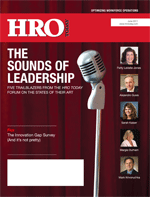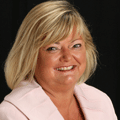 Five thought leaders from the HRO Today Forum share HR insight and wisdom.
Five thought leaders from the HRO Today Forum share HR insight and wisdom.
In The Wisdom of Crowds, author James Surowiecki relates a story about the famously snobby 19th Century anthropologist Francis Galton. A pioneer of surveys and statistics, Galton delighted in producing research that was designed to show the stupidity of the hoi polloi (no surprise that he was the guy who coined the word “eugenics” and championed its practice.)
In this anecdote, however, Galton’s misanthropic elitism receives a broadside. He is astonished when his poll of the crowd at a county fair reveals that their guesses as to the weight of a prize ox, when averaged, come to within one pound of the half-ton creature’s actual weight. More to the point, the crowd’s mean projection is closer than any of the individual estimates made by the attending “livestock experts.” Hence, the title of Surowiecki’s book.
It was H.L. Mencken who famously wrote, “No one ever went broke underestimating the taste of the American public.” And, of course, since there is no accounting for taste, this bit of cynicism cannot be disproved. But the aphorism has morphed into modern variants that disparage the collective intelligence, not just the “taste,” of the populace.
We repeatedly hear from this or that advocate about the stupidity of the masses. Yes, civilization has a history of mob rule and lynch mobs and kangaroo courts. Yes, the cognoscenti is often privy to more rarified information than the layman. But, happily, emergent social science increasingly demonstrates that reasonably informed crowds, with their collective intelligence organized under clear rules, more often than not lead us down the path to wisdom.
Our staff recently turned to our own variant of crowd-sourcing. During our recent HRO Today Forum in Las Vegas, we button-holed various attendees to ask them which practitioners from among their midst might be most “cover-worthy.” Although the list of worthies exceeded the five subjects who appear in the following pages, the profiles here indisputably display the mix of thought leadership and on-the-ground innovation that validate the wisdom of our crowd.
— The Editors
 Sweet Success
Sweet Success
Sara Lee’s procurement director knows the ingredients for cost savings.
By Debbie Bolla
Patty LaValle-Jones knows a thing or two about cutting spend. The director of procurement, marketing, and HR services for consumer goods conglomerate Sara Lee has taken on 30 HR initiatives that resulted in a whopping $35 million in cost savings. As if that weren’t sweet enough, her procurement team was able to contribute $22 million in cash-flow optimization savings.
Her secret? Being able to correctly identify organizational needs in order to deliver a strategy to obtain results. She says her achievements in procurement stem from her experience in sales management, where she learned the key skills for success: being able to listen and ask questions to define the specific expectations and desires of the client.
“I made the leap into procurement almost a decade ago and have been fortunate to support HR in order to improve employment engagement and company results,” she says. “My focus has been on developing people—people are really the greatest asset you have.”
Before joining Sara Lee in 2006, LaValle-Jones served a variety of operational roles at Sears Roebuck and APAC Customer Service. At Sears Roebuck, she implemented an enterprise-wide labor services program that reduced the number of suppliers by 73 percent and saved more than $6.5 million. During her current tenure, she has focused on streamlining HR process and procedures through strategic relationships. Her approach: using best-in-class organizations to oversee and execute tactical HR functions to free up HR generalists so that they can concentrate on key initiatives.
“We outsource some of the noncore functions so it allows them [HR generalists] more time to really focus on what’s critical, which is the employee engagement and development, verses some of the more transactional types of things,” she explains.
LaValle-Jones pinpoints three areas of improvement achieved by Sara Lee: absence management, health and welfare, and global contingent labor workforce management. (Sick leave, family leave, and disability fall under the umbrella of absence management.) LaValle-Jones says it was a particularly arduous process to streamline—but one that was well worth it.
“It was a challenge to outsource and a long project to get an idea of how we were doing, figuring out what our future state would be, understanding where the gap was, and then finding a supplier to support us,” she explains. “There were a lot of lean processes to go through, driving to the end result we wanted.” And that end result? An outsourcing partnership with Reed Group, producing a little more than $10 million in savings.
Also on the docket was outsourcing health and welfare, including medical and dental benefits. Aon Hewitt now handles this function. LaValle-Jones says an added bonus of the outsourcing relationship is the system’s meticulous compliance with the ever-changing regulatory laws driven by healthcare reform.
For the contingent workforce, LaValle-Jones and her team were seeking to improve service levels, end-user satisfaction, fill rates, and access to data. They partnered with Staff Management in 2008 to develop an MSP model for Sara Lee’s temporary labor. Success within this program—fill rates improved 24 percent, overtime usage down 40 percent—has encouraged the company to take the model global.
Through her experience and the ROI achieved, LaValle-Jones is a proponent of outsourcing and has a solid understanding of how to make it work. It begins with a thorough procurement process. The vetting of providers entails a bevy of interactions between the Sara Lee team and the group that will support them. LaValle-Jones takes stock of the rapport between teams.
“Even though we are outsourcing, we don’t want to disengage. We want those partners to act as an extension of our organization,” she says. The director of procurement also does her homework by cross-checking references and contacting clients that have walked away from previous relationships with providers to, as she says, get a sense of what went wrong and how Sara Lee can avoid that outcome (which they have achieved so far).
Buy-in is another buzzword in LaValle-Jones’s lexicon. She says, “The biggest thing throughout the process is that both parties have to be committed from the top level from both organizations to make the relationship work. In cases when we didn’t have executive buy-in from both sides, there wasn’t a level of understanding that we’re in this together; it’s like a marriage, and you need to work through it. There are going to be bumps, but you have to learn how to get through them together. And it’s how you do that that determines if it’s going to work or not.”
So what does she see on the horizon? Continued use of outsourcing for tactical, noncore functions, especially as the economy recovers and retention of high performers becomes key for HR generalists. She also anticipates the improvement of employee self-service centers, so that the experience can be positive as well as effective. Positive and effective: two adjectives that also sum up her opinion of outsourcing.
 The Numbers Guy
The Numbers Guy
Wolters Kluwer’s sourcing specialist knows dollars and sense.
By Katie Kuehner-Hebert
Alejandro Gusis enjoys strategic sourcing for one very good reason.
“I really like to negotiate, and I’m good at it,” quips the director of strategic sourcing and operational excellence at Wolters Kluwer. The Netherlands-based global information services and publishing company focuses on the market for professionals, including law, accounting, and healthcare.
In his current position, Gusis supports the firm’s human resources department, by sourcing through both recruitment process outsourcing (RPOs) providers and managed service programs (MSPs). Strictly sourcing human talent is a relatively new course for Gusis, who took on the specialized role for Wolters Kluwer five years ago.
“There is way more complexity in HR sourcing than buying telephone services, and I like that complexity,” he says.
Gusis, now an American citizen, was born in Argentina. He studied industrial engineering at the Buenos Aires Institute of Technology, graduating in 1994 with a degree in finance.
“I am a numbers guy,” he says. “I always liked math, and I chose this so I could bridge numbers with business applications.”
For six months, Gusis interned as a management consultant for Anderson Consulting in Buenos Aires, before becoming a senior buyer of facilities, materials, and services for Ford Motor Co.’s operations in Buenos Aires. During his tenure at Ford, he also served as country team leader in the transportation procurement office.
In 1998, Gusis moved north to Anchorage to take on a second internship as a financial analyst for Arco Alaska. While there, he developed the analysis for a new marketing program for natural gas in the Anchorage area, and generated a worldwide benchmarking system to determine Arco’s relative position within the oil industry. After his stint at Arco Alaska, he took time out to attend the Anderson School at the University of California, Los Angeles, obtaining an MBA with a concentration in finance in 1999.
“I was very strong in operations, but I needed even more of a finance background,” he says.
Gusis then served as a financial analyst for American Airlines in Dallas, managing the 2001 budget for the Latin America, marketing, and corporate real estate divisions. He moved back to Buenos Aires for a time to serve as a management consultant for A.T. Kearny. While there, he oversaw strategic sourcing initiatives for several Latin American companies.
Gusis returned to the states in 2003, as a senior manager for A.T. Kearney in the firm’s Chicago office. There, he managed several Internet-based strategic sourcing projects for state governments, as well as for companies in the healthcare, energy, and manufacturing industries.
In 2005, Gusis became a senior manager for the Blue Cross and Blue Shield Association in Chicago, in charge of development of the firm’s “Healthcare 2021 Vision.” He went to Wolters Kluwer in Riverwoods, Ill. in 2006, and is now second in command for the firm’s North America strategic sourcing program. As a buyer of both temporary and permanent recruitment services, Gusis says managing a blended workforce is critical.
“You need to have the technology and processes in place to source for that talent, contract that talent, onboard, and offboard,” he says. “You need to severe the relationship in a way that is very good, because you’ll want to have access to that talent in the future.”
Complicating that dynamic, the recession has created new stresses—because there are too many applicants.
“Right now, there is an oversupply of candidates because a lot of people are out of work,” Gusis says. “But at the same time, you have to do way more work in order to find the right candidates. It requires more work, so you have to leverage your MSP and VMS [vendor management software] technology in order to do that.”
The current economic conditions also bring into sharper focus the longstanding tightrope that is stretched between cost and quality.
“You can always buy cheaper, but it may not be better,” Gusis says. “Everybody wants the best talent, but nobody wants to pay for the best talent, so you’ve got to find the right balance.”
Perhaps one of the biggest challenges for organizations today is learning how to effectively deal with Generation Y employees. “Gen Yers want immediate gratification—they want to have value and meaning from day one,” he says. “If you don’t give Gen Yers feedback, they will change jobs immediately, and you’re losing talent. That’s a big challenge, and it has to be addressed in a different way than it was addressed in previous generations.”
With his breadth of background, Gusis is just the man for the job.
 No Place Like Home
No Place Like Home
Cabela’s HR leader is branding a small-town workforce with big ideas.
By Katie Kuehner-Hebert
When she was coming of age, Sarah Kaiser wanted to be anywhere but Sidney, the town of 6,000 in the southwestern corner of Nebraska where she’d grown up. Yet she has escaped by returning. Today, she heads the human resources department of Sidney’s largest employer, Cabela’s, which is fast becoming a nationwide retail presence.
When she was almost 16, Kaiser took a job as a receptionist at Cabela’s, one of the country’s largest catalog suppliers of hunting, fishing, and outdoor gear. ”I decided at that time in my life that I wanted to get as far away as I could,” Kaiser says. ”My parents supported this, but told me I had to tour three colleges before making a decision and I would have to choose somewhere with the option of being able to get home in a day.”
She picked Arizona State University, majoring in international business with a minor in Japanese. Then a visit home during the holidays changed her world, when she agreed to go on a blind date. She met her future husband and soon transferred to his college, University of Northern Colorado in Greeley, where she switched her major to communications.
Turned out her new husband had a dream—involving both Sidney and Cabela’s. ”Who would have known that the man I chose to marry had a life dream to work at Cabela’s!” she quips. ”So I thought okay, there must be more to this than what I had thought.”
Kaiser worked in human resources at Cabela’s, as a recruiter for IT while finishing her degree online. After graduating in 2003, she was offered a position as training manager. Kaiser had entered the HR field, she says, by sheer ”dumb luck.”
”Working as a receptionist, reporting through HR, I had developed relationships with them,” she says. ”When I came back from college, I told the director of human resources that I really enjoyed this great group of people, and would like to be a part of it.”
The constant change of the field is what keeps Kaiser in HR, she says. ”It allows me the ability to be creative in solutions—to be part of the pulse of the organization, as well as still have that employee touch.”
In 2006, Kaiser was promoted to senior manager of organizational development. In November 2010, she became the senior manager of talent, and within months was promoted again to director of human resources.
Meanwhile, Cabela’s was transitioning to a leading retailer, opening stores throughout much of the United States and Canada. The company currently counts 13,000 employees. And while the majority of the HR processes are in-house, Cabela’s outsources its payroll direct deposit vouchers and payroll tax payments, currently transitioning to ADP.
It was a result of this growth spurt and the challenges connected with it that Cabela’s chief executive officer Tommy Millner, who joined the company in 2009, asked the HR department to develop an ”employee value proposition.” Kaiser’s team turned to Kenexa, which specializes in employee surveys to develop organizational culture to help formulate Cabela’s proposition.
”We decided we needed something that blends both who we are and who we want to be—incorporating things we wish we could change,” Kaiser says. ”This would enable us to focus our recruiting efforts on individuals who could help us build upon the positive aspects of our corporate culture.”
Beyond commitment to excellence and passion for the outdoors, the proposition also showcased the kind of workplace that Cabela’s is now striving toward—one in which employees are rewarded for ”working smarter, not harder.”
”Before, hard work meant getting here very early and staying late. Our employees used to say, ‘We fight fires from 8 to 5 and do our real job from 5 to 8,’ ” Kaiser says. ”How do we change that culture, because who wants to go to work for a company like that?”
Employees are now rewarded for being responsible, leading teams, or for being inspiring leaders, she says. But there’s still the challenge for Cabela’s of recruiting top talent to live in a small remote town.
”We want to build off of the strong brand and reputation that Cabela’s has to attract the best candidates for our positions,” Kaiser says. ”We promote the benefits of living in a small town—you can go home for lunch, or take a walk outside in the fresh air. It’s not for everybody, but we’re up front about it. For the people who like that, we let them know that it’s a great place to work.”
And, for Kaiser, a great place to come home to.
 Computing Workforce Leadership
Computing Workforce Leadership
Once a service provider, Dell’s director of global HR Services “jumped over the wall.”
By Russ Banham
When computer giant Dell made its initial forays to establish operations in the Philippines, El Salvador, and Canada, Margie Durham was there to scout out talent. Of course, that was just the beginning. The director of Dell’s global HR services has since put her efforts behind optimizing the company’s HR shared services organization and leading the global expansion of contingent labor solutions, a largely outsourced function.
Dell’s HR shared services organization comprises multiple services that run the gamut from compensation and HR vendor management to the acquisition, onboarding, and management of talent. Not that this wide range of responsibilities is weighing Durham down in any way. “I’ve always been interested in learning more about the critical core areas to make an organization successful,” she explains. “And, since people are truly the most vital component for an organization to deliver, I wanted to be in the center of that.”
Not surprisingly, Durham started out at a recruiting agency. She “jumped over the wall” when one of the firm’s clients hired her. In 2004 Durham took a job in HR at Dell’s Round Rock, Texas-based headquarters, where she initially focused on recruitment strategy for Dell’s global start-up operations.
As she undertook the responsibility to establish HR and talent acquisition operations in Asia, Latin America, and Canada, she discovered she greatly enjoyed the twin purpose of delivering on Dell’s business goals and finding the right people to effect this. “I found it exciting to be on the ground during Dell’s global expansion and emotionally rewarding to help find people who were excited about working for Dell in these new markets,” this remains a career highlight for Durham. “I helped hire the HR teams and then got them trained, while simultaneously looking for company executives and future leaders.”
Durham subsequently transitioned back into a talent acquisition role in the Americas, followed by her current position in Dell’s HR services organization, where she is responsible for the vendor-neutral contingent workforce solution. In addition to this duty, she directs HR Services for the Americas, the company’s HR shared services organization. “We support the other HR functions like compensation, talent acquisition and vendor management, and HR data management, such as the employee records,” she says.
In her seven years at Dell, Durham has been a part of significant changes in the HR arena, which has progressed more toward the use of standard global processes, and the optimization of shared services. “In managing this transformation the HR organization was able to partner with company leaders to help drive organizational strategy and overall business direction.”
The transition in processes at Dell has allowed the company to transition some HR-related tasks from “high cost locations to best cost locations,” she adds. “For example, some of our shared services work used to be done out of our headquarters here in Round Rock, and we’ve been able to designate some regional hubs in Latin America, Asia, and EMEA [Europe, Middle East, and Africa] to do it now instead.”
Durham predicts that similar process globalization and optimization are in store for Human Resource organizations around the globe. “You have to find that sweet spot between providing operational excellence and contributing to cost savings in the current market and economic conditions—a delicate balance,” Durham explains. “As businesses become more globalized, support organizations must achieve this balance.”
Outsourcing is part of this new paradigm, a decision that must be made on a case-by-case basis, she maintains. “Outsourcing makes sense for some offerings but not all,” Durham says. “You must evaluate where you need flexibility and scalability. But, at the same time, you can’t sacrifice the customer experience.”
At Dell, Durham notes that the company hasn’t done a lot of outsourcing. “We do outsource contingent labor and some records management in different regions,” she says. “But, we still continue to manage core services internally.”
Like others in her field, she does not see a return to more traditional HR roles and practices. Says Durham, “The future is here now.”
 Witness to the Revolution
Witness to the Revolution
A veteran of HR’s huge transformations reflects on the state of the profession.
By Russ Banham
Mark Krivoruchka is one of the more broadly experienced HR executives you are ever likely to find. As the senior vice president of human resources at RSC Equipment Rental, Krivouchka brings one diverse background in people management to the role.
Before hiring on in March 2010 at Scottsdale, AZ-based RSC, one of the largest equipment rental providers in North America, Krivoruchka was a chief labor negotiator at General Electric. That was back in the days when the company lacked an HR department. In the mid-1980s he moved into GE’s non-union employee relations group, then became a member of the committee driving the company’s change management process.
Krivoruchka left GE for the opportunity to help Pillsbury transition its employee relations group into more of a modern HR department. He then did something he’d always wanted to do. “I became a general manager in operations,” he explains. “After General Mills bought Pillsbury [in 2000], it gave me the confidence to start up a couple of companies on my own.”
Working in operations also proved crucial when Krivoruchka took a position as Maytag’s senior vice president of HR. He oversaw much of the integration effort following Whirlpool’s acquisition of Maytag in 2005, and was later the president of its floor care products unit. That done, he hired on at Cooper Tire as its HR leader before joining RSC.
Despite his wide-ranging experience, the veteran executive is happy to return to the HR fold. He was drawn to employee relations as a career by a desire to “help an organization knock down the barriers to change,” he says. “I wanted to be someone who could strategically assist a company to drive culture change and find the right talent to lead it.”
During his career, Krivoruchka has witnessed dramatic changes in the HR arena. As he explains it, “In the past, HR was viewed more as a reactionary position—someone made a complaint, there was a labor issue or a strike, or somebody filed a civil suit, and it ended up on your desk, and you reacted to it. Today, HR is more strategic—it’s about what you are doing to make the organization achieve its goals.”
Modern HR leaders like Krivoruchka tend to focus on organizational culture, change management, and leadership development—as opposed to being the guy in the back office fielding questions about pensions and salary disputes. “We operate in an environment that is forward thinking and not necessarily reactive anymore,” he says. “Because of that, we have to be a true strategic partner who understands corporate priorities and objectives, as well as the business dynamics. Early on, HR was a job. Today it is a profession.”
That profession has altered markedly in just the last couple of years, he adds. Part of this transformation is due to the proliferation of social media and the real time nature of communications and information retrieval. No longer can HR wait until tomorrow to address problems that crop up today. “You better be in a responsive mode when something happens, because it will happen quickly,” he says. “One minute later it’s on YouTube, so your ability to respond has to be 24/7.”
Krivoruchka adds, “We’ve got more than 4,000 employees here, so the chance of something happening somewhere that is not good is pretty high. You need to be poised to manage this.”
Another change can be chalked up to technology. Employees, he says, are far more tech-savvy than before, using cell phones “more for texting, information, and apps than for talking.” HR must leverage such tools to maintain connectivity and engagement in the workplace, he adds, pointing out that “If you’re not an HR leader in tune with what is really going on in the world and in your business, it will be hard to get a seat at the table.”
From a more strategic standpoint, Krivoruchka says the biggest change in the HR world is greater dependence on the department to assist the senior leadership team and the organization to perform at a higher level. Part of this value proposition is being delivered by outsourcing non-strategic HR functions and services.
“I look at outsourcing two ways,” he says. “Is a function something I think I can add value to if we take ownership, ultimately giving us a competitive advantage? These tend to be areas like managing talent or setting up compensation systems, and so on. If the subject fails this test—like recruiting, benefit plans, or call centers—then we think about technology tools to handle it and/or outsourcing.”
Smart advice from a veteran of the past generation’s HR revolution.














